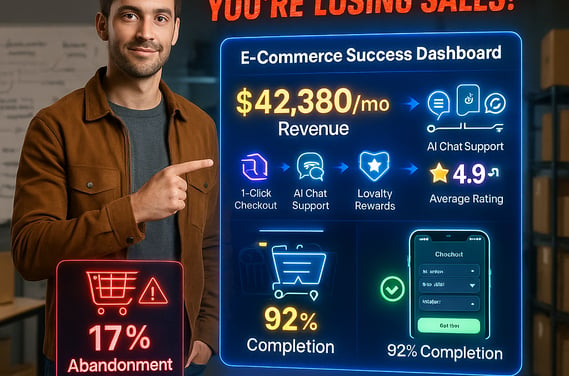The Top Website Features Every Successful E-commerce Site Needs
Discover the must-have features that can transform your e-commerce website into a high-converting, customer-friendly platform.
WEBSITE BUILDING & HOSTING
6/5/20254 min read


Introduction
In the competitive world of e-commerce, having a website that stands out is crucial. But what makes an e-commerce site successful? It’s not just about having a visually appealing design—it’s about incorporating features that enhance user experience, build trust, and drive conversions.
In this article, we’ll explore the top website features every successful e-commerce site needs. Whether you’re launching a new site or optimizing an existing one, these features will help you create a platform that attracts customers, keeps them engaged, and encourages them to buy.
1. User-Friendly Navigation
What It Is: Easy-to-use navigation ensures customers can find what they’re looking for quickly.
Why It Matters: Complicated menus frustrate users and increase bounce rates.
How to Implement:
Use a clear, intuitive menu structure.
Include a search bar with autocomplete functionality.
Add filters and sorting options for product categories.
Pro Tip: Use breadcrumbs to help users understand their location on your site.
2. High-Quality Product Images and Videos
What It Is: Clear, detailed visuals that showcase your products.
Why It Matters: Customers can’t physically touch or see your products, so high-quality visuals are essential for building trust and reducing hesitation.
How to Implement:
Use high-resolution images with zoom functionality.
Include multiple angles and close-ups of each product.
Add videos that demonstrate product features or usage.
Pro Tip: Use a consistent style for all product images to maintain a professional look.
3. Detailed Product Descriptions
What It Is: Comprehensive descriptions that provide all the information customers need to make a purchase decision.
Why It Matters: Vague or incomplete descriptions lead to confusion and abandoned carts.
How to Implement:
Highlight key features, benefits, and specifications.
Use bullet points for easy readability.
Include sizing charts, care instructions, or compatibility details where applicable.
Pro Tip: Use storytelling techniques to make your descriptions more engaging.
4. Customer Reviews and Ratings
What It Is: Authentic feedback from previous customers.
Why It Matters: Reviews build trust, reduce purchase anxiety, and provide social proof.
How to Implement:
Display reviews and ratings prominently on product pages.
Allow customers to upload photos or videos with their reviews.
Respond to reviews to show that you value customer feedback.
Pro Tip: Use third-party review platforms like Trustpilot or Yotpo to showcase authentic reviews.
5. Secure Payment Options
What It Is: Multiple, secure payment methods that cater to different customer preferences.
Why It Matters: Limited or insecure payment options can deter customers from completing their purchases.
How to Implement:
Offer popular payment methods like credit cards, PayPal, and Apple Pay.
Display security badges to reassure customers.
Ensure your payment gateway is PCI-compliant.
Pro Tip: Include buy-now-pay-later options like Klarna or Afterpay to attract budget-conscious shoppers.
6. Mobile Optimization
What It Is: A website that performs seamlessly on mobile devices.
Why It Matters: Over 70% of e-commerce traffic comes from mobile devices, so a mobile-friendly site is essential.
How to Implement:
Use a responsive design that adapts to different screen sizes.
Optimize page speed for mobile users.
Simplify navigation and checkout for smaller screens.
Pro Tip: Test your site on multiple devices and browsers to ensure compatibility.
7. Fast and Reliable Hosting
What It Is: A hosting provider that ensures your site loads quickly and remains accessible.
Why It Matters: Slow-loading sites frustrate users and lead to higher bounce rates.
How to Implement:
Choose a hosting provider with high uptime guarantees.
Use a Content Delivery Network (CDN) to speed up content delivery.
Regularly monitor your site’s performance and address any issues.
Pro Tip: Consider managed hosting services for better performance and security.
8. Clear Calls-to-Action (CTAs)
What It Is: Prominent, easy-to-find buttons that guide users toward desired actions.
Why It Matters: Vague or hard-to-find CTAs reduce conversions.
How to Implement:
Use action-oriented language like “Buy Now” or “Add to Cart.”
Make CTAs stand out with contrasting colors.
Place CTAs in prominent locations, such as above the fold.
Pro Tip: Test different CTA designs and placements to see what works best.
9. Robust Search Functionality
What It Is: A search bar that helps users find products quickly and accurately.
Why It Matters: A poor search experience frustrates users and increases bounce rates.
How to Implement:
Include autocomplete and suggestions in the search bar.
Allow users to filter search results by category, price, or other criteria.
Ensure the search function can handle typos and synonyms.
Pro Tip: Use tools like Algolia or Elasticsearch to enhance your site’s search capabilities.
10. Post-Purchase Support
What It Is: Resources and assistance to help customers after they’ve made a purchase.
Why It Matters: Good post-purchase support builds loyalty and encourages repeat business.
How to Implement:
Provide order tracking and delivery updates.
Offer easy returns and exchanges.
Include FAQs, tutorials, or customer support contact information.
Pro Tip: Use automated email sequences to keep customers informed and engaged after their purchase.
Real-World Example: How These Features Boosted Sales
Let’s look at a real-world example of how incorporating these features helped an e-commerce brand increase sales:
The Problem:
An online electronics store had a high bounce rate and low conversion rate.
The Solution:
By adding detailed product descriptions, customer reviews, and a robust search function, they saw a 30% increase in conversions and a significant reduction in bounce rates.
Conclusion
Incorporating these essential features into your e-commerce website can transform it into a high-converting, customer-friendly platform. By focusing on user experience, trust-building, and functionality, you can attract more customers, keep them engaged, and drive sales.
Start implementing these features today, and take your e-commerce business to the next level!
